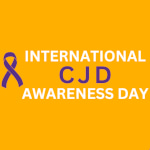International CJD Awareness Day Date in the current year: November 12, 2025
 International CJD Awareness Day is observed on November 12. It was created to raise awareness of Creutzfeldt-Jakob disease and other prion diseases, a group of progressive, incurable, and invariably fatal conditions associated with the degeneration of the nervous system.
International CJD Awareness Day is observed on November 12. It was created to raise awareness of Creutzfeldt-Jakob disease and other prion diseases, a group of progressive, incurable, and invariably fatal conditions associated with the degeneration of the nervous system.Prions are abnormally shaped proteins that can cause normal proteins in the brain to change shape. This process spreads like a chain reaction, damaging brain cells and leading to progressive, incurable, fatal diseases collectively known as transmissible spongiform encephalopathies (TSEs) or prion diseases.
The most common prion disease in humans is Creutzfeldt-Jakob disease (CJD). It is named after the German neurologists Hans Gerhard Creutzfeldt and Alfons Maria Jakob, who in the 1920s described a disease believed to be CJD. However, it wasn’t until 1982 that American neurologist Stanley Prusiner coined the term “prion”. Fifteen years later, Prusiner was awarded the Nobel Prize in Physiology or Medicine for discovering prions.
There are three main forms of CJD: sporadic, genetic, and acquired. Sporadic (idiopathic) CJD accounts for 85% of cases. It develops without an apparent cause and primarily affects people over the age of 60. About 10-15% of CJD cases are genetic. Genetic CJD is inherited in an autosomal dominant pattern, meaning the child of an affected parent has a 50% chance of inheriting the disease.
Finally, acquired CJD accounts for fewer than 1% of cases. It has two subtypes: iatrogenic CJD and variant CJD. Iatrogenic CJD can be transmitted by contaminated surgical instruments used during brain surgery, corneal transplants, dura mater grafts, or pituitary human growth hormone treatments. Variant CJD is transmitted by consuming beef infected with bovine spongiform encephalopathy (mad cow disease) or by receiving an infected blood or plasma transfusion.
The early symptoms of CJD are non-specific and often overlooked. They include subtle memory problems, confusion, personality or behavior changes, poor coordination, clumsiness, and vision problems such as blurred or double vision. These symptoms worsen as the disease progresses. Later symptoms include memory loss, severe dementia, involuntary movements (myoclonus), blindness, deafness, impaired speech, loss of balance, and an inability to move independently. Eventually, patients fall into a coma and die.
CJD progresses rapidly and inevitably leads to death. About 70% of patients die within a year of diagnosis. There is no cure or effective treatment for CJD. Treatment is palliative and may include clonazepam or sodium valproate to treat involuntary movements, opioids to manage pain, sedatives and antidepressants for psychiatric symptoms, such as anxiety and depression, etc.
International CJD Awareness Day was created to raise awareness of CJD and other human prion diseases, such as Gerstmann-Sträussler-Scheinker syndrome, fatal insomnia, kuru, and variably protease-sensitive prionopathy. The day’s main goals are to raise public awareness of these diseases and encourage further research into finding better treatments and, ultimately, a cure.
- Category
- International Observances
- Tags
- International CJD Awareness Day, international observances, awareness days, prion diseases, Creutzfeldt-Jakob disease